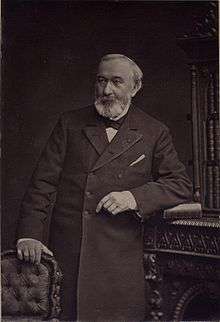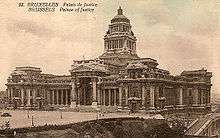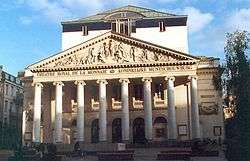Joseph Poelaert
| Joseph Poelaert | |
|---|---|
 | |
| Born |
21 March 1817 Brussels, Belgium |
| Died |
3 November 1879 (aged 62) Brussels, Belgium |
| Nationality | Belgian |
| Occupation | Architect |
| Buildings |
Law Courts of Brussels |
Joseph Poelaert (21 March 1817 – 3 November 1879) was a Belgian architect.
Life
Born in Brussels to Philip Poelaert (1790–1875), a former architecture student at the Académie Royale des Beaux-Arts in Brussels, Poelaert also trained there under Tilman-François Suys, and then in Paris under Louis Visconti and Jean-Nicolas Huyot.
Poelaert first came to attention with his winning competition entry for the Congress Column in 1849. He was made city architect of Brussels in 1856.
Poelaert's most significant commission was the colossal Law Courts of Brussels, the largest single building constructed in the 19th Century and even copied in smaller scale at the Palace of Justice in Peru.
During construction the inhabitants of the Marollen quarter, the working-class neighbourhood site of the Law Courts, gave Poelaert the nickname “Skieven Architect” (roughly, ‘the crooked architect’) because the long period of construction drove many inhabitants out of their houses, with the help of the local police. The nickname refers also to "chief architect" because many of the workers of the Law Courts were English. The local inhabitants corrupted "chief architect" to "skieven architect", with a totally different meaning in the Brussels dialect.
Poelaert himself was residing in the heart of the Marolles rue des Minimes in a house adjoining his vast offices and workshops and communicating with them.[1]
Poelaert Place, the largest square in Brussels, lies before the courts building.
He is buried in Laeken Cemetery under a miniature version of his own Palais de Justice. Poelaert was the great-uncle of Belgian architect Henri Van Dievoet.
Works
- the Congress Column, 1850–1859
- the church Sainte-Cathérine/Kathelijnkerk in Brussels, 1854–1874
- the Church of Our Lady of Laeken, site of the Royal Crypt of the Belgian royal family, begun 1854, consecrated in 1872, completed 1909
- restoration of the Théatre Royal de la Monnaie, Brussels, after the fire of 1855
- Law Courts of Brussels, 1866–1883
Gallery
- Tomb of Poelaert in the Laeken Cemetery
- base of the Congress Column
 postcard of the Palais de Justice
postcard of the Palais de Justice Théatre Royal de la Monnaie, Brussels
Théatre Royal de la Monnaie, Brussels Sculpture of Joseph Poelaert at the Law Courts of Brussels.
Sculpture of Joseph Poelaert at the Law Courts of Brussels. Birth certificate of Joseph Poelaert, born 21 March 1817, Brussels.
Birth certificate of Joseph Poelaert, born 21 March 1817, Brussels. Marriage certificate of the architect Joseph Poelaert, Brussels 25 aug. 1859.
Marriage certificate of the architect Joseph Poelaert, Brussels 25 aug. 1859. Death certificate of architect Joseph Poelaert, deceased 3 nov. 1879.
Death certificate of architect Joseph Poelaert, deceased 3 nov. 1879.
Notes
- ↑ Poelaert et son temps, Bruxelles, (catalogue exposition), 1980, p. 166: "Il habitait une maison rue des Minimes, voisine de ses bureaux et qui communiquait avec ceux-ci"
External links
-
 Media related to Joseph Poelaert at Wikimedia Commons
Media related to Joseph Poelaert at Wikimedia Commons